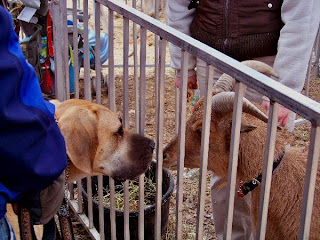I was down on the beach yesterday with my girl enjoying the sunshine and warm sand. I was watching the antics of dozens of dogs as they played like puppies in the fresh spring air.
A young Weimaraner, no more than three or four months in this world, came bounding over to us, stopping every few steps on the way to scent our energy.

Wide-eyed and innocent, he bellied up to Journey the last two feet, bowing low to a dog of such stature.
I give the little guy an A+ for confidence and bravery.
When he felt assured he wasn't going to be gobbled up in one gulp or stomped into the sand by one giant paw his whole back-end started wagging exuberantly while his front-end was doing a frenzied introduction dance. He was both humbled and thrilled!
Journey studied him with disdain, weighing out in her mind just how much energy she would have to expend on humouring this slightly obnoxious, young upstart.
Just as I was settling in to enjoy the entertainment there was a shrill, "Peppy--come here," in the distance.
I saw a male figure strutting across the sand and once again the command, "Peppy, come!"
My girl switched her focus from the pup toward the approaching voice. The pup was totally oblivious to anything other than his desire to impress us, if not with his brains then with his self-importance and cuteness.
("Look at me, I'm a pup, I'm playing with you, I'm adorable, look at me! I'm a pup.")
Once more, from ten feet away, a thunderous, "Peppy, you come here--NOW!"
The pup now identifying his master's voice above the sounds of the wheels going around in his tiny brain, turned from us, ran enthusiastically over to Peppy Sr., twirlled around and darted right back to where his new-found friend was, paying Peppy Sr. no more attention.
Peppy Sr., without as much as a how-do-you-do, closed the gap between us, reached down, grabbed young Peppy roughly by the collar and proceeded to give him a tongue-lashing.
"I told you to come! You know better than that--you come when I call you."
All the while, Peppy could have cared less, trying his best to squirm away from Sr. in an attempt to get back over to us.
("Let go of me--can't you see I'm trying to show-off for this dog? I'm socializing!!")
I could have kept my mouth closed. I could have reached into my pocket for that duct tape more than one person has suggested I carry with me but I never seem to remember it. Besides my pockets are for dog treats and doggy bags.
"Peppy is wonderful. How old is he?"
"He's almost four months old--with a mind of his own," Sr. states grabbing onto Peppy's collar again.
(well, who else's mind could he have in there but his own??)
"You've taught him to come already?" . . . I'm impressed.
"He knows better than to take off like that when I call him," he states with exasperation.
Really?? Hmm . . .
"No he doesn't-not at this age," I venture. "Actually, this is the age they learn there's no umbilical cord attaching them to their human, that they actually have a choice as to whether or not they do what you ask."
"He'll want to please you by doing what you expect of him once he understands what that is," I rant on. "That can only come by conditioning, spending time teaching him the expected response to a command."
"For a high-energy dog like this," I add, " I think you should consider using a ball--make the teaching fun so he doesn't realize he's learning."

Holding his pup by the collar, front feet now off the sand as Peppy struggles, still trying in vain to escape, I hear, "Now that is a beautiful dog you've got."
"Wish my guy would hurry up and settle down."
(Hurry up and settle down?!?! Boy, has he got a lot to learn about his chosen breed!)
I realize my advice has fallen on ears as deaf as Peppy's were when Sr. had yelled at him to come.
"He's not really a settle-down kinda breed," I reply as light-heartedly as I can. "He's got alot of energy and joy to spread. He's going to need tons of exercise and challenges to keep him focused."
"His parents are both smart dogs--they're champions," he offers, as he leads a thrashing Peppy away by the collar.
As I watch them wander off, I know Peppy will only be as 'smart' as his owner teaches him to be.
With Sr.'s comment about a four-month-old Weim settling down, I can't help wonder if this is another pup who was purchased without thought to the genes behind that adorable face.
Is Peppy destined to join the thousands of others of his breed in rescue organizations due to lack of education on both the breeder and the purchaser's parts?
Guess that will all depend on how smart Sr.'s parents are!
 The Toronto Humane Society on River Street is back, under a court approved agreement.
The Toronto Humane Society on River Street is back, under a court approved agreement.










 There are no instant results--unless of course, you just stick the pups into the 'safe place' (as pro-craters like to call a cage) and get on with your life.
There are no instant results--unless of course, you just stick the pups into the 'safe place' (as pro-craters like to call a cage) and get on with your life.




 How the officials are planning to carry out these 'spot checks' is not made clear.
How the officials are planning to carry out these 'spot checks' is not made clear. 




















 We had some friends come visit from out-of-town today, accompanied by their sweet, if not overly self-conscious and insecure Great Dane.
We had some friends come visit from out-of-town today, accompanied by their sweet, if not overly self-conscious and insecure Great Dane.




